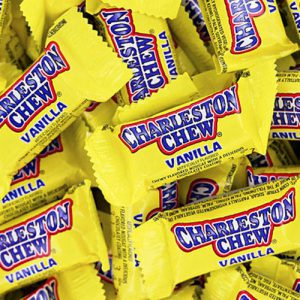The Charleston Chew transports me to my childhood.

Growing up in 90’s coastal California, this 1920’s anachronism was sold only at the independent pharmacy near my house. That pharmacy also happened to have the best local parking lot for skateboarding. I spent many foggy San Francisco Saturdays sitting on the curb, gnawing at the long strip of taffy-like substance coated in a thin layer of chocolate. Charleston Chews are much more than a candy — they’re a taste of my adolescence. Nostalgia in a bright yellow wrapper.
Nostalgia (from the Greek nostos, meaning “to return home,” and algia, meaning “pain”) can be paraphrased as “the longing for home.” It is a vivid emotional experience in which objects, events, or places, trigger a “sentimental longing for the past” (Muehling, Sprott, & Sultan, 2014). But unlike simply recalling memories, our nostalgic mode idealizes the past, viewing it through proverbial rose-colored lenses. And it brings with it a tinge of sadness: things were simpler; better back then (Davis, 1979; Hirsch, 1992; Holak and Havlena, 1998; Wildschut et al., 2006).
NOSTALGIA IN ADVERTISING
The advertising industry is no stranger to the persuasive power of nostalgia, epitomized by this classic clip from Mad Men. But there’s much more insight to be gained from a dive into the psychology of nostalgia.
TWO KINDS OF NOSTALGIA
1) Personal nostalgia is a longing for idealized events from one’s own personal experience. It’s perfectly exemplified by my Charleston Chew obsession: a bite of the candy bar has me longing for experiences from my own personal past. These events may be utterly idiosyncratic – no one else I know associates Charleston Chews with parking lots or skateboarding – but they need not be. Personal nostalgia can still be shared with others, provided that the nostalgic triggers, and the experiences triggered by them, are widely shared.
For example, this “Child of the 90s” ad for Internet Explorer clearly targets millennials by eliciting a personal nostalgia for the 90s, referencing Oregon Trail, Fanny Packs, and Hungry Hungry Hippo — items with which many people had personal experience.
2) Historical nostalgia is a longing for a past not personally experienced, but idealized through cultural channels such as movies, books, and other depictions. For history buffs, the Charleston Chew–first created in 1925 in Cambridge, Massachusetts and named after the famous dance from that era–may bring back a historical nostalgia for the Roaring 20s, even though the longed-for era may not have been personally experienced.
Millennials watching this Bacardi ad may experience a historical nostalgia. The goal need not be to influence viewers through their own direct experience at 1950s parties, but rather lead them to view Bacardi as a “classic” brand with a history.
Which one should you use?
It depends on the type of product being advertised. Personal nostalgia is more effective in driving key ad effectiveness metrics for products used personally or on your own (e.g. your personal vehicle), whereas historical nostalgia is more effective for products that are consumed publicly or with others (Chang & Feng, 2016). For this reason, Bacardi’s use of historical nostalgia is a wise strategy, as rum is often consumed in public, social contexts.
WHY IS NOSTALGIA EFFECTIVE IN ADVERTISING?
The psychological mechanisms.
Affective Transfer: Advertisers who use nostalgia are capitalizing on the psychological mechanism of “affective transfer” (Hobson & Patrick, 1995), in which the positive emotions from one experience (nostalgia) transfers or becomes associated with other stimuli in the context (the ad/brand/product eliciting the nostalgia).
Creating a personal connection with the brand: By inducing viewers to reminisce about their own personal past or imagine themselves in a beloved era, nostalgia generates self-referencing thoughts. Mixing thoughts about oneself with thoughts about the ad creates the impression that the ad is “speaking to them.” Ads that generate such a personal connection with the viewer are much more effective (Escalas, 2004).
BEST PRACTICES WHEN USING NOSTALGIA IN ADVERTISING
Context Matters
In general, people with higher life satisfaction are more affected by nostalgia (Ju, Jun, Dodoo & Morris, 2017). The same applies in advertising: nostalgic ads are more effective when viewers are in a positive mood (Sedikdes et al. 2008; Zhao, Muehling & Kareklas, 2014). If you can catch your audience when they’re in a positive mood –whether induced by your ad, or by the ad context (advertising during a positive or lighthearted show) — it’s likely to be more effective.
Make it social
The effect of nostalgia, like so much in advertising, is more effective when people share the experience. In a clever study looking at Pinterest posts, Youn & Jin (2017) found that the difference between nostalgic and non-nostalgic posts was even more pronounced when looking at posts with a high number of pins and likes. The lesson? If you can make people feel socially connected – like what they’re seeing is something other people are engaged in and care about – then nostalgia will be even more effective than usual.
Don’t mix facts and feelings
But use of nostalgia does have some risks. Compared with non-nostalgic ads, viewers of nostalgic ads recalled fewer aspects of the ad’s message, such as key product features or other details (Muehling & Pascal, 2011). If you’re thinking about using nostalgia as a tactic, first decide whether your primary goal is to communicate a lot of information, or generate a feeling. Nostalgia is best suited for the latter.
All in all, the research on the effects of nostalgia in advertising lead to a few key pointers:
DO’s:
- Differentiate personal from historical. Personal nostalgia is ideal for products consumed or used alone, whereas historical nostalgia may be better for publicly used/consumed products.
- Get them in a good mood. Nostalgia is most effective when viewers are in a positive state.
- Leverage social influence. The effect of nostalgia is even greater when consumers think that others feel similarly.
DON’Ts:
- Don’t pack in too much messaging. Nostalgic ads drive emotion, but listeners may tune out your messages. Don’t throw in too many facts when you want your viewers to feel something!
